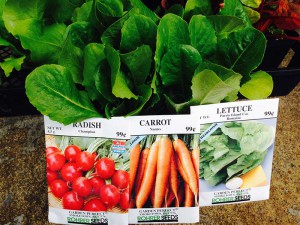Enjoy a family adventures starting vegetables from seeds
By Cathy Branciaroli, Food Correspondent,The Times

Planting seeds for a summer garden is a great family project. Vegetable plants can also be gotten at local garden centers.
Starting seeds that will grow to produce this summer’s garden bounty and then nurturing a backyard garden plot can be a fun family project. It’s the miracle everyone wants. You plant a seed in the soil, add a little water and sunshine, and soon you’re eating what you grew. Plus, kids are delighted to see the results of their efforts, and a child will eat the most amazing things if he or she grew them.
So, with the ground finally warming up after our long, cold winter, now is the time to get going. If this is your first experience of starting seeds, it’s wise not to take on too much. Start with three or four varieties. Later in the spring, you can supplement with young plants purchased at the garden center, including vegetables like tomatoes or peppers that take much more effort to nurture from seed.
Starting seeds is not complicated or difficult. The basic ingredients are good soil, sunlight, water and attention.
Harold Taylor, head gardener for Longwood Gardens’ vegetable gardens, suggests using a hard rake to break up the soil in the area where you intend to plant, then laying the rake handle down several times across the space to create depressions. This results in straight rows in which to sow the seeds. A little soil smoothed on top of the seeds and you’re ready for action, starting with gentle watering.
He also advised that it will take a week or two for the seeds to sprout, or germinate, depending on the weather, so don’t despair if you don’t see any action for a while. Just keep a close watch on the rows where the seeds were sown for the first hints of green.
Here are some vegetables that are great for home gardens, and for involving the children of the family:
Radishes – These root vegetables have a peppery taste. They offer the advantage of maturing faster than anything else–in three to four weeks, so offering an early payoff for the kids. In addition to eating them raw in a salad or as a snack, you can roast them drizzled with olive oil for a great side dish.
Carrots – After the kids sow these edible roots they should wait six or seven weeks before pulling one up to see whether the carrot is ready to eat. Plan to harvest early. Like most root vegetables, they are tastiest when young and tender. You can plant a second crop of carrots in late summer for fall harvest. Carrots add a sweet note to soups and sauces, and often are simmered whole in spaghetti sauce to balance out the tart flavor of the tomatoes.
Peas – These guys like the cool weather of spring but it’s not too late to sow them for a May or June harvest. Peas are a clinging vine, so be sure to provide a trellis, a teepee of sticks or some other kind of support. Snow peas have edible pods but kids can have fun helping shell other varieties. Spring pasta dishes using peas are a great way to enjoy them.
Lettuces – Salad greens grow quickly and you can enjoy head lettuce, leaf lettuce and more exotic arugula or radicchio. Sow in batches about two weeks apart so as the different batches get big enough to eat, you will be able to enjoy fresh greens over a longer period. For simple salad dressings, try just vinegar and olive oil (1/4 cup vinegar to 3/4 cup oil) seasoned with herbs, salt and pepper.
Seeds can be gotten from any garden center or big box store. There are any number of seed companies. A fourth generation family seed business is Rohrer Seeds in nearby Lancaster. Their website offers growing tips. www.rohrerseeds.com.
Cathy Branciaroli also writes about her adventures in the kitchen on her blog Delaware Girl Eats




